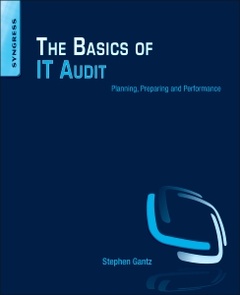Description
The Basics of IT Audit
Purposes, Processes, and Practical Information
Author: Gantz Stephen D.
Language: English
Subjects for The Basics of IT Audit:
270 p. · 19x23.4 cm · Paperback
Description
/li>Contents
/li>Readership
/li>Biography
/li>Comment
/li>
The Basics of IT Audit: Purposes, Processes, and Practical Information provides you with a thorough, yet concise overview of IT auditing. Packed with specific examples, this book gives insight into the auditing process and explains regulations and standards such as the ISO-27000, series program, CoBIT, ITIL, Sarbanes-Oxley, and HIPPA.
IT auditing occurs in some form in virtually every organization, private or public, large or small. The large number and wide variety of laws, regulations, policies, and industry standards that call for IT auditing make it hard for organizations to consistently and effectively prepare for, conduct, and respond to the results of audits, or to comply with audit requirements.
This guide provides you with all the necessary information if you're preparing for an IT audit, participating in an IT audit or responding to an IT audit.
- Fundamentals/Key Concepts
- Auditing in Context
- Internal Auditing
- External Auditing
- Types of Audits
- IT Audit Components
- Audit Drivers
- IT Audit Processes
- Methodologies & Frameworks
- Organizations, standards & Certifications
- Appendices
IT Security Professionals (Security Auditors, Security Engineers, Compliance Specialists, etc.), IT Professionals (Network Administrators, IT Managers, Security Managers, Security Analysts, Directors of Security, etc.)
Steve’s security and privacy expertise spans program management, security architecture, policy development and enforcement, risk assessment, and regulatory compliance with major legislation such as FISMA, HIPAA, and the Privacy Act. His industry experience includes health, financial services, higher education, consumer products, and manufacturing, but since 2000 his work has focused on security and other information resources management functions in federal government agencies. His prior work history includes completing projects for government clients including the Departments of Defense, Labor, and Health and Human Services, Office of Management and Budget, Federal Deposit Insurance Corporation, U.S. Postal Service, and U.S. Senate.
Steve holds a master’s degree in public policy from the Kennedy School of Government at Harvard University, and also earned his bachelor’s degree from Harvard. He is nearing completion of the Doctor of Management program at UMUC, where his dissertation focuses on trust and distrust in networks and inter-organizational relationships. Steve currently resides in Arlington, Virginia with his wife Reneé and children Henry, Claire, and Gillian.
- Provides a concise treatment of IT auditing, allowing you to prepare for, participate in, and respond to the results
- Discusses the pros and cons of doing internal and external IT audits, including the benefits and potential drawbacks of each
- Covers the basics of complex regulations and standards, such as Sarbanes-Oxley, SEC (public companies), HIPAA, and FFIEC
- Includes most methods and frameworks, including GAAS, COSO, COBIT, ITIL, ISO (27000), and FISCAM
These books may interest you

Internal Audit Practice from A to Z 160.25 €



